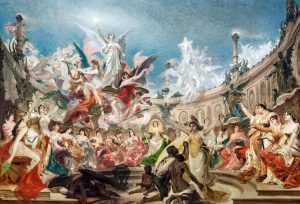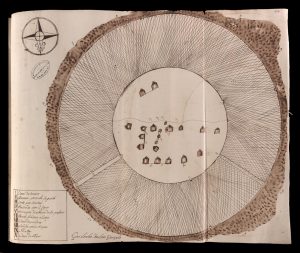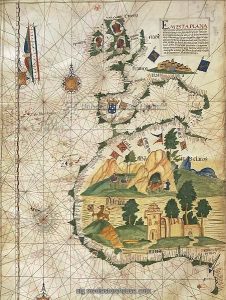As the class moved on, we started to talk about racism after the abolition of slavery. Brazil was seeking for progress and modernity in the late 19th century, and the Thursday class also related the past and the present through current events. Even though Brazil has progressed far since the colonial era, racism is still a problem in the society. We first discussed the article “Use of Blackface in Brazil Carnival Parade Sparks Debate” from the Washington Post because the use of blackface in the parade in Sao Paulo raised a huge controversy. From Americans’ point of view, blackface in the parade would be considered as cultural appropriation and racist. The question is whether this form of cultural appropriation is considered racist in Brazil as well. Cultural appropriation means that people from another culture perform and dress in the cultural context without knowing the meaning behind. Some Brazilians were offended by the blackface as well, whereas others did not. The parade group never meant to be offensive, but to stress the artistic element of Afro-Brazilians. “Cultural appropriation” would be an academic phrase to debate across cultures.
The parade that took place recently has been a popular topic to discuss about Brazil. Race has raised ambiguity in Brazil as well. The History and Culture Blog Post presented an article about a British woman who lived in a Brazilian community participated in the parade as a foreigner. She had devoted three hours a day to prepare, and she has successfully blended into Brazil. It raised the question that if a white immigrant would be relatively easier to gain social acceptance in Brazil than other race groups. The Book Presentation also reflected on Brazil’s race and social issues after the abolition of slavery. Vales of Tears: Revisiting the Canudos Massacre in Northeastern Brazil by Robert Levine explored the racial tension in the Backlands of Brazil. Canudo with approximately 30,000 residents were heavily poor after the abolition, and mainly populated with Afro-Brazilians. Canudo was trying to progress, which is also similar to the article presented later in the class on the question of degeneration. Under the Catholic leadership of Antonio Conselhiro, he and his followers strived to build up a utopian society with no crimes. The life in the Backlands of Brazil was also a challenge because it was not perfectly hospitable to people to live. Due to the long drought and no farming, the famine grew.
To better prepare for our future research, we also learned about how to write an abstract and identified topic, gap, methods or materials, argument and conclusion from “Puffy Ugly Slothful and Inert: Degeneration in Brazilian Social Thought 1880-1940” by Dain Borges. The article was about degeneration after the abolition of slavery and the author raised about the question of if Brazil was backsliding socially, racially and physically. Degeneration means that a backsliding in the society. Borges argued, “Degeneration, though never far from color in Brazil, was more than color. ” Borges started to present degeneration from the perspective of race. Some scientists used scientific racism and claimed that some Brazilian whites were inferior due to the fact that they lived in the tropics, and miscegenation berated the country. Nevertheless, Brazil took this philosophy differently by stressing whitening the society to improve. That was why the society came up with the ideology of whiteness means progress, but blackness shows degeneration. While race was not the only issue in the society, the Brazilians started to look at the public health and physical appearance of the country because Brazil that time had regional widespread of diseases and physical hygiene of places. Some psychiatrists interpreted in a way that those physical health and social problems were led by hereditary and race. Some Brazilians incorporated race in various social issues and attributed problems to race. Race has always been a concern when Brazilians are striving for progress in their society even though they were considering the degeneration.
There could be potential exam questions on social progress, degeneration and racism. I would like to write up questions like: Describe what degeneration means in Brazil and why would they think degeneration was an issue in their society. What aspects of degeneration was involved and how did the Brazilians cope with the idea of degeneration? How did the Brazilians make progressions under race tensions?
Below are the potential sources for further reading.
Sources:
“The Danger of Cultural Appropriation – the Ongoing Whitening of Brazilian History”,
Black Women of Brazil. June 21, 2015. https://blackwomenofbrazil.co/2015/06/21/the-danger-of-cultural-appropriation-the-ongoing-whitening-of-brazilian-history/
This article proposed that white people in Brazil adopted Afro-Brazilian culture in their attire as a kind of fashion. The website argued that the cultural appropriation under the whitening society led people started to forget about Afro-Brazilian culture when the whites dressed up that way.
Zanardi, Luiza. “Why the Need to Understand What Exactly Cultural Appropriation is
Painfully Real Like Brazil”. Affinity. March 3, 2017. http://affinitymagazine.us/2017/03/03/why-the-need-to-understand-what-exactly-cultural-appropriation-is-is-painfully-real-in-countries-like-brazil/
Zanardi argued that cultural appropriation in Brazil would be inappropriate. She proposed that after understanding the meaning of Afro-Brazilian struggles, the example of wearing turban would be showing disrespect.
Fachinetti, Cristiana. Psychiatry in Context: the Problem of Degeneration in Brazil. Directed
by Institute of Historical Research. October 4, 2016; London: School of Advanced Study University of London, n.d. Podcast.
http://www.history.ac.uk/podcasts/latin-american-history/psychiatry-context-problem-degeneration-brazil.
This podcast lectured the history of how Brazilians looking at degeneration psychologically and ways to regeneration from psychiatrists.




